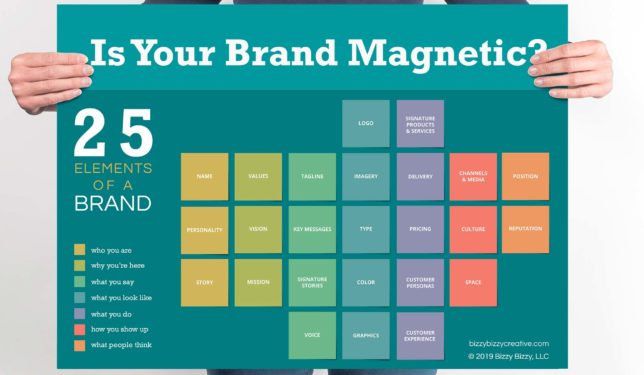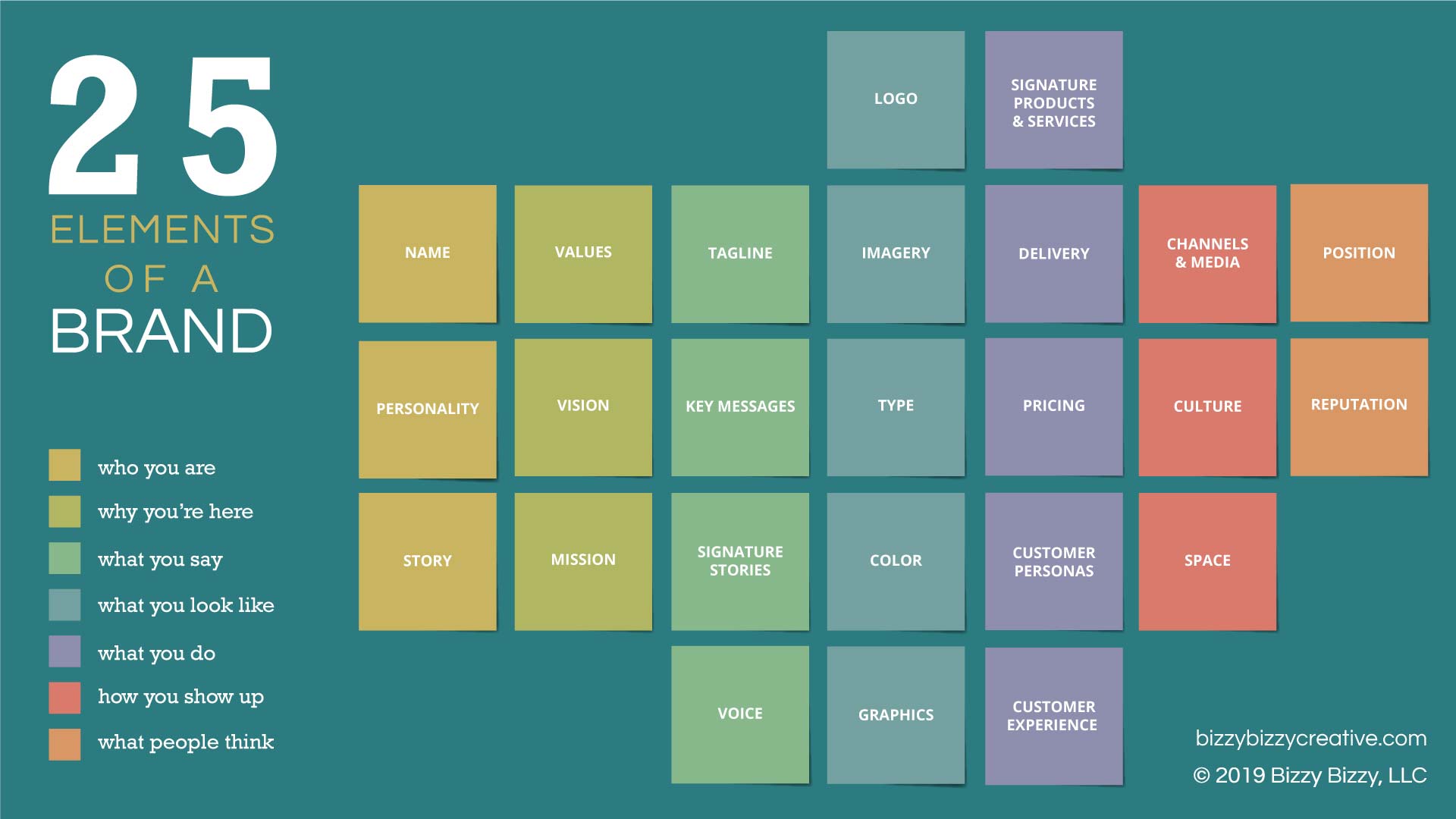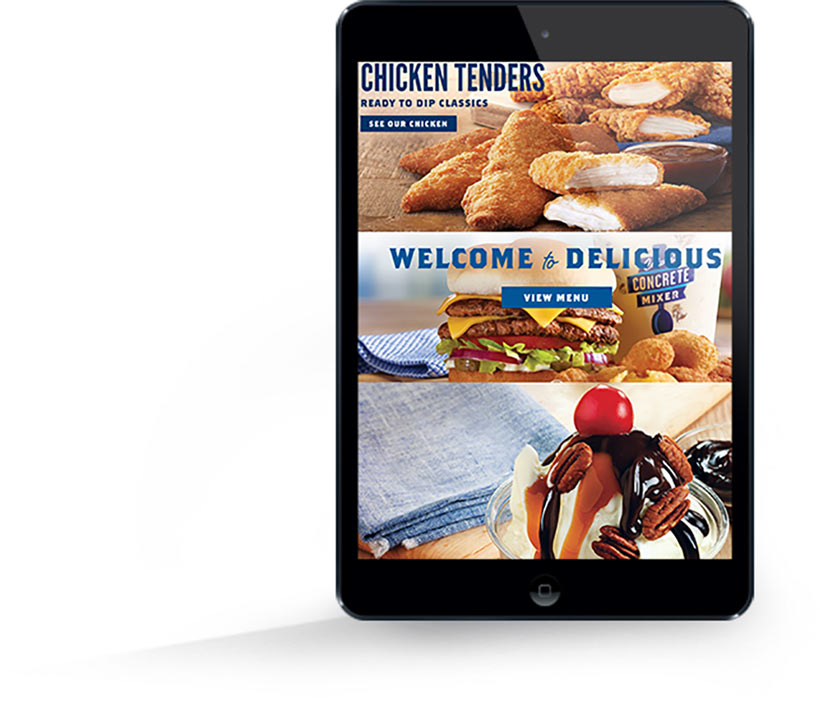25 Elements of a Brand: The Complete Guide to Creating a Magnetic Brand
Quick Links
What is Branding and Why is it Important?
A lot of people think branding is all about having a logo and color pallet. Those things are an important part of any brand identity, but that’s just scratching the surface of what’s possible with branding.
At the most basic level, all brands need visuals to convey their message. But for holistic branding, you need to consider your position, what’s at the heart of the business and all the various touch points in a customer’s journey. There are many elements within every brand that can be mined and polished to be made distinct to create value. And that’s what branding is all about.
In order to get a deeper understanding, let’s get down to the basics of what is branding and why is it so important.
A brand can take the form of a person (or character), a business, an organization or a product.
For the sake of this article, we’re going to be talking about your brand as if you are starting a business. But most of this still applies if you are establishing your personal brand, creating a new product or starting a nonprofit or other type of organization.
In the simplest definition of a brand, it’s who you are, who you want to be and how people perceive you. Branding is the work you do to try to control or influence people’s expectations, perceptions, behaviors and experiences in order to drive revenue.
This is a key point: the purpose of branding is to drive revenue. If you are a solopreneur and you don’t need any more customers, and you are perfectly happy with the amount of money your business is bringing in, you may not ever need to work on your brand.
But if you are trying to grow your business, advertise, outsource marketing tasks, raise your prices or attract more customers, that’s where branding helps.
All successful brands have a strong sense of identity, one that mirrors the hopes, fears and dreams of their target customers. Your brand should emotionally connect your audience to your business.
When done well, branding should:
- Get people to notice you;
- Increase awareness about your products and services;
- Attract the right type of potential customers;
- Differentiate you from the competition;
- Create a positive perception and accurate expectations of your products and services;
- Build ongoing customer loyalty;
- And drive revenue.
Internally, branding should:
- Create clarity and focus;
- Help you recruit and retain staff;
- Guide and motivate staff;
- And influence pricing, products and services.
The Work of Branding
The work of branding usually means investing either time, money or both in the following areas:
- Advertising;
- Marketing;
- Design;
- Messaging;
- Strategy;
- Customer experience;
- Employee training;
- And culture development.
For example, branding work might include hiring a graphic designer to design a logo, a pattern library or special graphics for your website. Or branding work might be investing in the interior design of your physical space. Or branding work could include spending time crafting micro-experiences to ensure a truly consistent brand message across your entire marketing funnel. If you have employees, you might require customer service training or a specific dress code to create a deliberate customer experience. All of these things add value to your brand.
No matter what type of work you do, the more you invest in branding, the more valuable your brand becomes.

The Value of Branding
Research shows brand preference creates value by measurably improving profits, price premiums and market share.
A study of 220 consumer products by the Marketing Science Institute (MSI) found that a superior brand preference or reputation commanded price premiums of 26% on average, even when brand quality is the same.
In other words, people will pay more to do business with brands they’ve heard of and brands they admire.
25 Elements of a Premium Brand
There are lots of different approaches to branding, and there is a lot more to it than just hiring a graphic designer to make you a logo. So you may wondering what you can do to polish your brand today.
We’ve identified these “25 elements of a magnetic brand” and categorized them as follows:
Who You Are
- Name
- Personality
- Story
Why You’re Here
- Values
- Vision
- Mission
What You Say
- Tagline
- Key Messages
- Signature Stories
- Voice
What You Look Like
- Logo
- Color
- Imagery
- Type
- Graphics
What You Do
- Signature Products & Service
- Delivery
- Pricing
- Customer Personas
- Customer Experience
How & Where You Show Up
- Channels & Media
- Culture
- Space
What People Think
- Position
- Reputation
Now, you might be feeling a bit overwhelmed. You’re thinking you need to go out and hire a fancy branding agency to work on each of these 25 elements.
You could definitely do that. But you probably don’t need to. Many of these things you may already have working for you in your business, but you just haven’t codified them. In other words, you haven’t written it down and made it official! In other cases, you may need to do some self-exploration in order to narrow in on the pieces that make sense for your business.
Mining and polishing the elements of your brand that make you distinct is how you can differentiate yourself and start creating that valuable brand preference. But not every brand needs to work on all 25 elements of a brand. Most brands will naturally bring forward a just a few of the elements that make the most sense for them.
So let’s take a peek at each element of branding. We’ll briefly explain what it is and give you an example of a famous brand that has “polished” that element and made it a big part of their business strategy.
Building a Brand Around Who You Are
Brand Name
The brand name is just one tiny part of the overall brand strategy, but it is an important one. Whether you are naming a startup or a product, you need to settle on a name before you can move forward with other branding and marketing tasks. You can’t very well create a logo or design a website without a name.
A good name should match the essence of your brand, help you attract the right audience, possibly convey information about your products or services, and be a primary ingredient in becoming a well-loved, unforgettable brand.
Considering these tips up front ensures you are not overlooking opportunities or potential problems:
- Make sense.
- Make it short.
- Make it memorable.
- Make it easy to pronounce and spell.
- Consider the value and risk of including descriptive words.
- Don’t forget your audience.
- Determine whether you want to stand out or fit in.
- Consider whether the name limits your scalability.
- Make sure the name is available.
For an in-depth look at the do’s and don’ts of naming your business, get our guide on how to name your business or product.
To create a truly unique brand name, try making up a new word. To help in that creative process, we’ve designed a deck of prefixes and suffixes Word Mashup Cards. You can use these to add to key words that have to do with your business in order to come up with a new word that will be more readily available when it comes to domains and trademarking.
Brand Name Example: Panera Bread
Panera Bread has an awesome brand name. The word “Panera” comes from a combination of the Italian words for bread (pane) and time (era). So put together, it loosely means “the age of bread.”
What’s so great about this name is that it’s a made up word, so it was easily trademarked. Plus, it was likely easy for them to get their social media channel handles, and get their website ranked in the top position for on search engines like Google. Conversely, sandwich competitor Subway would have had a harder time with those things because they are using a common word.
Panera is short, easy to spell and easy to pronounce. And what’s more, it works well in all Latin-based languages. So whether you’re in the U.S., France, Italy or Argentina, “Panera” is easily recognizable as somewhere you can get bread and fresh baked goods! Well done, Panera!
Brand Personality
Even if your brand isn’t a personal brand or you’re not a solopreneur, you want your brand to feel like someone your customers know, like and trust. This is why we often personify businesses and talk about brands as if they were a person.
So your brand’s personality is just like a person’s personality, which is a characteristic way of thinking, feeling and behaving.
Your brand personality is also known as a brand archetype. The concept of archetypes were first introduced by famous psychologist Carl Jung in the 1940’s. The idea behind using archetypes in branding is to align your brand personality with something already embedded within the conscious and subconscious of humanity. Aligning with a brand archetype makes the brand easier to understand and remember for both the business owner and the customer.
There are 12 classic brand archetypes:
- The Innocent
- The Regular
- The Hero
- The Outlaw
- The Explorer
- The Creator
- The Ruler
- The Magician
- The Lover
- The Caregiver
- The Jester
- The Sage
Each archetype will naturally attract and emotionally connect to a certain type of consumer. Knowing what the strengths and weaknesses of your primary archetype can help you better market to that group.
Take our free quiz to find out your brand’s personality!
Brand Personality Example: Harley Davidson
Harley-Davidson’s primary brand archetype is The Outlaw. One of Harley-Davidson’s customer personas (we’ll talk more about those later) might be a white, upper-middle class, balding insurance agent who spend most his time in a business suit. He spends most of his time playing by the rules and “doing the right thing,” but there is a part of them that is rebellious. He buys a Harley motorcycle in order to feel a bit edgy and counter-culture. He wants to feel like a badass. He wants to feel cool.
Now, just because The Outlaw is your primary brand archetype doesn’t mean you’ll have the same customer personas as other Outlaws. Another Outlaw example is Hot Topic. They sell music and pop-culture inspired clothes and accessories. A customer profile of theirs might be a punky, rebellious, tattooed, angsty Asian-American teen girl who spends most of her time on YouTube and playing video games. She buys blue hair dye and a spiked dog collar necklace at Hot Topic in order to feel edgy and counter culture. She wants to feel like a badass. She wants to feel cool.
So you can see, no matter what your customer demographics are, using archetypes helps your brand tap into a personality that will share the hopes, dreams and emotions of your audience. And those feelings are the same no matter who your customers are or how you’re reaching them.
Brand Story
Your brand story is the narrative that tells how your company came into existence. The goal of a good brand story is to inspire a positive emotional reaction and sear it into the brains of consumers.
Our brains are wired to respond to stories. Research shows that storytelling is the best way to capture people’s attention, make them remember something and forge a connection with them.
A brand story might use facts (i.e. we started our company in 1995 in Seattle) and also personal anecdotes (i.e. our founders met at the airport security line when they accidentally grabbed each other’s briefcase). Above all, your brand story should feature the people at the center of your origin story. After all, even with large brands, customers want to know about the human beings behind the products and services. People want to do business with people.
Your story may include biographical info, credentials or fun facts about all the important “characters”. All these elements should be woven into an intriguing narrative and told within the overall personality, voice and editorial guidelines of the brand.
Not all companies will have an interesting brand story, in which case, your brand story will not be something you highlight. But with a compelling brand story, your audience will remember you and forge a deeper connection with your brand.
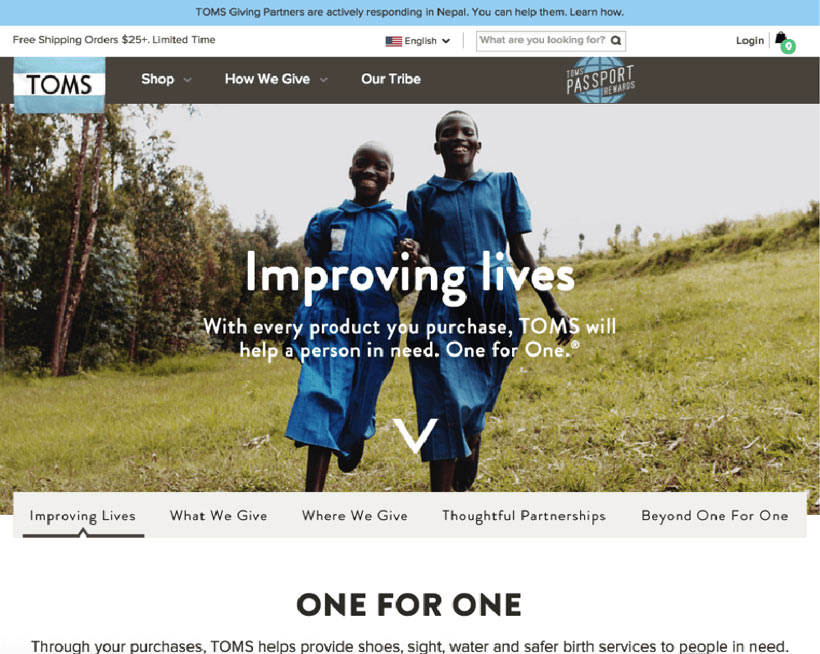
Brand Story Example: TOMS Shoes
TOMS Shoes uses their brand story as a foundation for their existence. The story goes that founder Blake Mycoskie travelled to Argentina and was intrigued by the style of the “alpargata” shoe worn by many locals. He wanted to make a version of those to be sold in America. Then he found out that many children in Argentina were in need of shoes. And he felt compelled to solve that problem.
TOMS’ tagline, “One for One,” means that for every purchased pair TOMS gives a pair of shoes to someone in need. TOMS’ business model is known as the “one for all concept,” which comes directly from their brand story. It’s not just a compelling and memorable narrative — it’s the basis for their entire way of doing business. Largely because of this story, they’ve developed a massive and loyal following.
Building a Brand Around Why You’re Here
Core Values
In one of the most popular TED Talks of all time, Speaker Simon Sinek talked about how “Starting with Why” can help leaders and brands inspire their colleagues and customers into action. In other words, telling people why you do what you do (instead of focusing on what you are selling) is a powerful way to connect with people.
Core values are at the heart of a brand’s “why.” They serve several purposes (both internal and external). Core values:
- Create the vision;
- Guide decisions and influence behavior;
- Act as the heart of the brand;
- Help differentiate the business from its competitors;
- Build customer loyalty;
- And aid in recruiting and retention.
This is big stuff! A business without core values will flail amid tough decisions and blend in with all the rest. If you’ve never defined your brand’s top five core values, now is the time. You can use our deck of Core Value Cards to help!
Core Values Example: Salesforce
Salesforce is a software that manages customer relationships. Their core values are:
- Trust
- Customer Success
- Innovation
- Equality
In their staff training program, understanding what’s behind their brand core values helps establish culture and influence behavior. According to their website, “these four core values are the driving force behind everything we do at Salesforce. They serve as our North Star, guiding us to always stay true to ourselves and what we stand for, and to act accordingly.”
When you have a brand core value like “Customer Success,” that means you need to live by it. For example, on the Salesforce website, they have a 1-800 number at the very top of the home page. They know in order for some customers to be successful using their software, they need to be able to easily call and talk to a person to get help. Hiding that phone number or forcing people to go though a bunch of hoops to get to customer service would not align with the brand value. So you can see how the core values can actually influence decisions big and small in the everyday operations of a business.
Vision Statement
A vision statement is a formal summary of a brand’s long-term, big-picture goals. While it’s easy to get caught up in the day-to-day of running a business, a vision statement helps your brand keep steering toward a goal in the future. To write a vision statement for your business, think about how you, your audience, your community or the world will be different if you achieve your goals and purpose.
The vision statement might be time-bound and measurable, for example, projecting 5 or 10 years in the future. It should capture what you aspire to be and do. Your vision statement should be no longer than a couple of sentences.
Brand Vision Statement Example: Susan G. Komen
Susan G. Komen’s vision is simple: “A world without breast cancer.” Their mission is to prevent and find a cure breast cancer. If they were to achieve their mission, we would be living in a world without breast cancer.
That may seem simple enough, but having that vision in place can keep them from going to far down a different path. For example, it may be tempting at times to become a research foundation that also tries to research other kinds of cancer or to partner with a drug company that treats breast cancer but does not cure it or prevent it.
Mission Statement
The mission statement is a formal summary of the aims and values of a brand. It’s more action-oriented than the vision statement. It is the soul of the business that inspires everyone involved. It may include the “what,” “how” and “why” of your business strategy. It captures, in a few sentences, the essence of your business’s goals and the philosophies behind them. It defines what the company does for its customers, employees and owners and possibly the community or the world.
To write a mission statement for your brand, think about why a customer would choose you over competitors. Ask yourself why you are in business? Define what you do for customers. What is the level of service you offer or the nature of your products? Who are the key players (owners, employees, suppliers or partners?) What are the broad business goals?
Make it specific to your brand but general enough that you won’t need to change it every six months. Test it by asking yourself whether your competitors could use exactly the same statement. If so, you need to do more work in defining what your competitive advantage or “secret sauce” is.
Every word counts, so don’t be afraid to use a thesaurus to find bold or unusual words that will help you stand out and more clearly communicate your goals and value to the world.
Brand Mission Statement Example: Patagonia
Patagonia is an outdoor apparel brand. Their mission statement is “We’re in business to save our home planet.”
Patagonia’s strong values are what creates such a strong brand preference and brand loyalty for their customers, who are willing to pay more for their products. They are so proud of their values, in fact, they feature the “Inside Patagonia” tab as one of two main buttons on their website navigation, right next to the Shop button. This page talks more about their values, mission and vision, and the projects and commitments to saving the planet.
Building a Brand Around What You Say
Tagline
A tagline is a short catch phrase or sentence that adds character, depth, description or detail where the business name itself falls short. A tagline doesn’t need to be a complete sentence, but it can be. It is often used right after the business name is spoken aloud, such as in a radio or TV ad or when answering the phone. In design, it often is positioned near — but not as a part of — a brand’s logo.
A tagline is a great way to quickly explain what it is you sell when it’s not clear from the business name and differentiate yourself from your competitors. The tagline might be the “what” or the “how” of the business. Or it might be your brand’s promise to consumers. For example, Geico’s tagline of “15 minutes or less can save you 15% or more on car insurance.”
Taglines are often easier to remember than a business name (especially if the business name is an acronym or something not all that memorable).
Brand Tagline Examples: Dollar Shave Club and Kentucky Fried Chicken
Dollar Shave Club’s tagline is “Shave Time. Shave Money.” We’re not usually a big fan of puns, but this one is clever on many levels! It describes the unique selling points of the company and also adds humor. For just a few words, it’s a very hard-working tagline!
Kentucky Fried Chicken’s tagline “It’s finger lickin’ good.” was a hallmark for many years that was so famous it became “memeable”. They eventually changed it, in part because the translation in some languages sounded more like “Eat Your Fingers Off.” Keep in mind if you’re a global brand you’ve got to think about those translations carefully!
Key Messages
Key messages may also be known as a brand summary or an “elevator pitch.” A key message answers the questions “What do you do?” and should be something you can say within a 30-second elevator ride with a stranger. When building a brand, you should be able to tell consumers succinctly who you are in an easy-to-grasp way.
A key message goes into more detail about what you sell and who your customers are than a mission statement does. It should encapsulate some of the same elements from your tagline, mission and brand positioning statement (more on that later), including what differentiates you from your competitors. The key message could be similar to your “unique value proposition.” It may also include what problem you are solving for your customers, so people understand why they need your product or service and why they should care. A key message helps to keep marketing efforts focused and aligned.
Your key message should identify two or three “brand triggers” that will be the critical to building the foundation for emotional bonds in your marketing.
You should hone your key message to the point where you can say it in your sleep. You’ll use your key message as the starting point every time you start a new social media account, fill out an online profile, or have a conversation at a networking event. It can be shortened or lengthened depending on the size of blurb you need, but always start with the key message to ensure consistency in the language, tone and order of things. You may want to create a key message for each of your major products or services. And it’s a good idea to have a few variations of key messages for different purposes (i.e. selling, introducing, building credibility).
When done well, your key message should explain your business to someone for the first time, and—even if they don’t know your industry—they should have a basic understanding of what you do.
Key Message Example: Starbucks
At Starbucks, their key message is “We sell great coffee. We’ve always believed in serving the best coffee possible. It’s our goal for all of our coffee to be grown under the highest standards of quality, using ethical sourcing practices.”
This key message helps them differentiate themselves from, say, Dunkin’ Donuts, who might be more focused on affordable and convenient coffee rather than “quality” and “ethically sourced.” You’ll notice this key message isn’t a catchy tagline, and it isn’t a list of core values, but it incorporates some of the same ideas that could be used in those brand elements.
Signature Stories
A signature story comes in the form of an anecdote about the company, an employee or perhaps a testimonial or case study from a customer. Unlike a standard testimonial or case study, a signature story is the folklore of the company—an example of an extreme or something amazing.
According to Prophet Vice Chairman David Aaker, “A signature story is an intriguing, authentic, involving narrative with a strategic message that clarifies or enhances the brand, the customer relationship, the organization, and/or the business strategy.”
A signature story is not a set of facts. Unlike facts or features, a signature story evokes emotion and may involve characters and have a once-upon-a-time feeling. Most of all, it should be interesting and memorable. The more interesting and memorable it is, the more your story will get shared.
“Advertising is the price you have to pay for not being interesting enough.”
Just like other aspects of your brand, when you tell your signature stories frequently and consistently, the more they will be embedded in the consciousness of consumers. Keep in mind that your brand story might be one of your signature stories, especially if it is really memorable or compelling on some way.
Read more about signature stories from David and Jennifer Aaker.
Signature Story Example: Nordstrom
Nordstrom has a famous signature story that goes like this: “In the 1970s, a customer walked into a Nordstrom store in Fairbanks, Alaska to return two used snow tires without a receipt. The salesperson, relying on his top-notch training knew what to do. He returned the snow tires and refunded the customer’s money.”
But of course the amazing part is that Nordstrom doesn’t sell tires!
This signature story was used over and over at Nordstrom’s. It brings to life the generous return policy and excellent customer service that they are known for and proud of.
Brand Voice
Brand voice is the tone and style in which you speak or write and the language and words you use. Brand voice shows up in every marketing channel, including your website, social media, TV and radio advertising, as well as in how you and your staff speak to people in real life, on the phone or in email.
As a solopreneur, your brand voice might come naturally to you. However, as your business grows and content creation is outsourced to others, brand voice guidelines become imperative. Without a clear brand voice, you could find yourself with a random assortment of voices and tones and word choices that could, at best, weaken your brand and, at worst, could actually confuse or upset potential customers.
You’ll want to decide things like whether to use “you” versus “our customers.” You should develop editorial guidelines that outline common words and phrases that have unclear punctuation, abbreviations and other usage issues. For example, should you always hyphenate “user-friendly” when talking about your software?
Download our free Brand Voice Chart Template to help you find your brand voice. And check out our Brand Voice Exercise to help you identify the top characteristics of your brand voice.
Brand Voice Example: Royal Caribbean
Royal Caribbean cruise line has a very specific audience of customers who they call “seekers.” They define these folks as atypical cruisers. To appeal to them, their brand voice states: they are clever but not “ha-ha funny.” They are conversational but not forced cool. They are adventurous but not extreme. Setting these brand voice parameters—including the “We are NOT” section—helps avoid a writer or customer service agent taking a concept too far.
Building a Brand Around What You Look Like
Logo
The logo is the element that arguably gets the most credit in branding. A logo is a graphic mark, emblem, or symbol used to promote public identification and recognition. For brands, the logo typically depicts the business name in a distinct typeface and may also contain a graphic symbol or design that can be used with or without the business name.
The word “logo” is often used interchangeably with the word “brand” because of the word’s roots in cattle ranching. Ranchers would brand a cow with their specific mark to claim ownership of it. If the cow wandered off, anyone could tell whose ranch it belonged to.
While most brands aren’t in the business of searing their logo on the hide of living animals, they are hoping to sear their businesses logo into the hearts and minds of potential customers.
A great logo should immediately connect a consumer’s brain to the business in question, without the need to see or hear its name.
To be effective, a logo should be:
- Original;
- Simple;
- Appropriate for the business;
- And memorable.
If you look at the 10 most memorable logos, according to one survey, all of them involve a simple graphic icon. It’s no accident that these logos are just as recognizable when they are a tiny icon on a Twitter account as they are on a billboard.
One of the most common mistakes clients make when going through the logo design process is trying to make the logo too complicated. Attempting to combine too many disparate concepts into one mark often leads to an awful logo. For example, trying to combine the state of Wisconsin, a tooth, and an orchid might seem like a good idea for Wisconsin’s Wild Orchid Dentistry, but remember, the logo doesn’t have to do all the work. You have 24 other brand elements to tell your story!
Another common misconception for clients getting a logo designed is they think “I’ll know it when I see it.”
Surprisingly, logo design rarely happens that way. The logo design process is iterative, and takes both a talented designer and client feedback to get it right.
Sagi Haviv, partner at Chermayeff & Geismer & Haviv, points out that the best logos of all time aren’t exactly works of art that people go gaga over immediately upon seeing them.
“It’s never love at first sight,” Haviv says. “A good logo, a good trademark, gains meaning and power over time.”

Brand Logo Example: Nike
You might think a symbol as powerful and recognizable as the Nike “Swoosh” was designed by a fancy advertising agency in New York with a team of designers who collectively had decades of experience. And you might guess it cost an arm and a leg to develop, like some of these famously expensive brandings.
But actually, the logo designer, Carolyn Davidson, was a graphic design student who was hired in the 1970s by Phil Knight, founder of Nike. She reportedly designed the logo for $35. The design was meant to show movement and resemble a wing of the Greek goddess Nike.
Knight initially said he didn’t love the logo but he launched his shoe brand with the swoosh anyway. It has since become one of the most famous logos of all time for a brand that has an estimated value of $16 billion.
Imagery
Imagery is one of the often overlooked aspects of branding. It’s very common for marketing or social media staff to turn to stock photos to visually tell a story. And if the stock photography isn’t chosen with intention, it’s common for consumers to feel like the brand isn’t authentic or that it’s not always telling the same story.
So whether you use stock photos, get professional photos taken, or take amateur photos with your phone, consistency is the key.
The goal is that your images are so “on brand” a consumer can recognize them as yours even while furiously scrolling through Instagram. Consistency is why your customer will pay attention to you among the thousands of images they see every day.
Some tips for finding good stock photos are to look for consistency in these areas:
- Content: Are the photos of people, inanimate objects, landscapes, etc.?
- Angle / composition: Is the photo always from above or straight on? What is the depth of field and focus?
- Lighting: Find images with similar lens, filter or lighting you can apply to each shot?
- Color: Make sure color usage is similar in terms of saturation, contrast and how much color is in each shot. Consider whether you can consistently use photos that highlight your brand colors.
- Tone / emotion: If there are people in the images, are they always positive, or do you want to show pain or other negative emotions?
Stock photos get a bad rap when there is exaggerated emotion or when you try too hard to illustrate something in a literal way. For example, if you are writing a blog article about finding your target market, you don’t necessarily need to find a photo of a target to make your point. A nice photo of a person will do just as nicely. But with that said, if it’s on brand for you to show exaggerated emotion, go all in and find the worst stock photos out there!
If you decide to take your own photos, set up a photoshoot and do a big batch all at once. Consider:
- Signature props: What artifacts, special objects or backdrops can you use to tell your brand story or distinguish your photos?
- Signature filter: Is there a certain filter or color screen you will apply to every photo?
- Clothes: Will the subjects wear any certain colors, style or even uniforms or costumes?
- Color palette: What is the overall color scheme, the backdrop and level of saturation?
- Angle / composition: How zoomed in and at what angle will the photos be taken? What angle best tells the story and showcases the scene or products?
- Lighting: Is there a certain lens or lighting scenario you can apply to each shot?
Brand Imagery Example: Culver’s
Culver’s has a very specific aesthetic to their mouth-watering food photography. They use mainly neutral colors with the food as the main focus. They use a few signature props, including a wooden cutting board and a Culver’s blue napkin in many of the shots.
If you look at their Instagram account, pretty much every image contains their brand blue color, including user-generated content. In one photo of a cute French bulldog, even the dog’s color was Culver’s blue! That’s serious attention to imagery detail.
Type
Typography is the style and appearance of written text. The word “font” is often used to describe a particular flavor of typeface in design. When a company is designing a brand identity, a consistent set of fonts should be used to maintain visual familiarity and readability.
Fonts contain subconscious messages, carry meaning and incite emotion, even for consumers who are not fluent in typography. When a brand has very distinctive typography, that becomes an instantly recognizable part of the brand identity.
Many corporations, however, tend to play it safe and choose more ordinary fonts for their logos in order to have a more timeless brand. Check out some of these examples of major companies that rebranded and toned down the typography and personality.
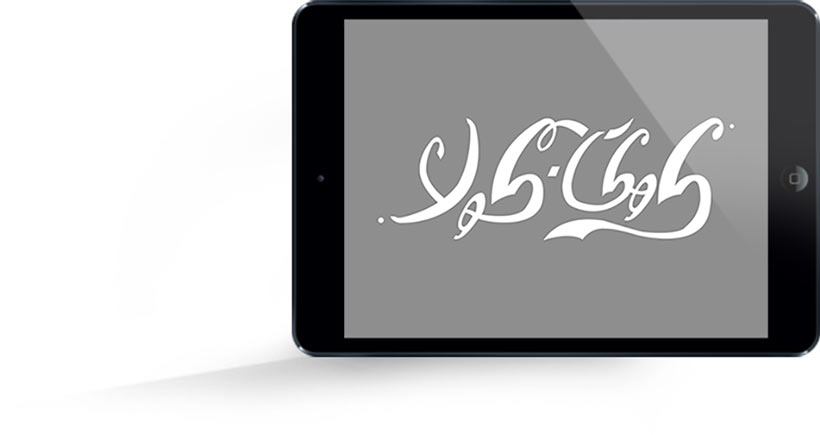
Brand Type Example: Coca-Cola
Even when the word Coca-cola is written in a foreign language and when you don’t see the brand colors, the custom type is so distinctive, you need not read the words to connect it to the brand. Because it is hand-rendered (not a font installed on every PC in America) this custom lettering can’t easily be copied!
One downside to custom lettering like this is that…well…someone has to hand draw it, which means it won’t be readily available for designers to type just any old word or to use as a web font. In this case, other fonts will need to be chosen for wide use.
Keep in mind that heavily stylized fonts like this should be used sparingly in design and in combination with other more basic, legible fonts.
Color
Color theory has been long used in branding—and especially logo design—in an effort to establish brand identity and evoke certain emotions from consumers. For example, blue has been said to create a sense of trust, which is why many corporations such as Facebook and CitiBank use it in their branding.
Limiting the primary color pallet to three or fewer colors is advised in most cases to ensure recognizability. If you choose only one color, you’ll be competing with many other brands for it. But if you choose more than three, you dilute the power of instant recognition.
You can choose neutrals, secondary colors and accent colors to be used on other materials, but the logo itself is usually best designed in two or three colors, depending on how complex it is. Establish brand guidelines around color usage for consistency.
Once you choose the colors for your brand, you should use the exact color formulas to re-create them across all your print and digital materials. We recommend using a Pantone swatchbook to pick out the colors in real life and then translate them onto a screen. Pantone is the industry-recognized color-matching system that printers and designers will understand.
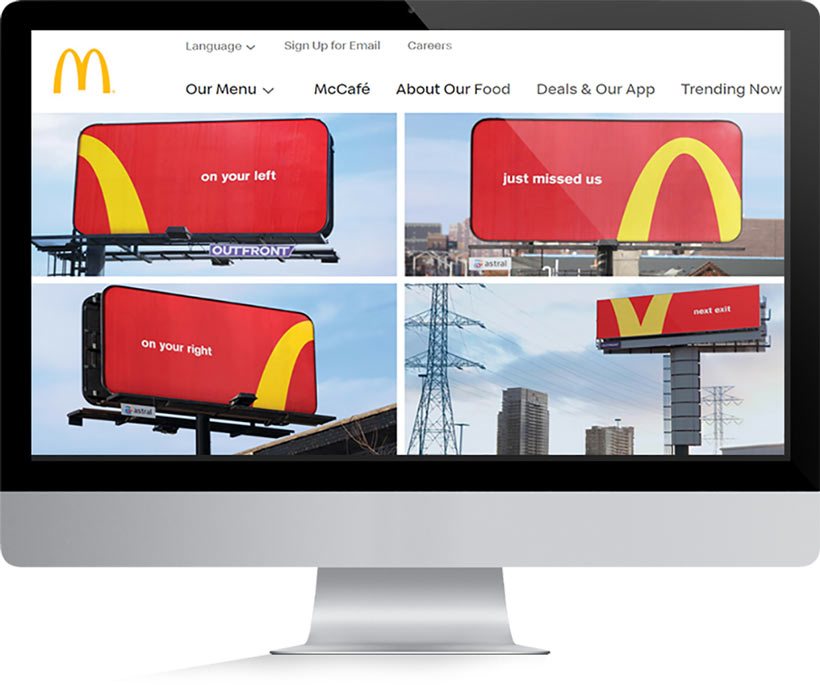
Brand Color Example: McDonald’s
McDonald’s uses the colors of ketchup and mustard in its branding, a reference to the well-loved condiments on its burgers and fries. What’s more, some say both red and yellow can actually stimulate hunger!
Their colors and brand are so well known, they are able to get away with billboards like these where they don’t even need to show the entire logo or icon in order to get brand recognition. This is the holy grail of brand recognition!
Practically no other major company wants to jump on these two colors for branding because they immediately conjure the famous fast-food restaurant.
Graphics
Brand graphics may include iconography, illustrations, patterns, borders or other types of background or decorative elements. Graphics can be used to tell a story, add texture or depth, aid in understanding or be purely decorative.
By using brand graphics, you can really add personality, flexibility and value to the brand’s visual assets, especially when the logo itself might be somewhat simple.
Graphics should be designed by a professional designer who can match your exact color pallet and create visuals that can be used on anything from a billboard to a business card.
Brand Graphics Example: Birchbox
Birchbox is a subscription box for beauty products. Due to the nature of what they are selling and how they are selling it, it’s important that Birchbox has beautiful and exciting packaging for their products.
As a disruptor in the beauty product industry, Birchbox wanted their brand to stand out with playful, lively and down-to-earth branding. This drew a stark contrast to many mainstream cosmetics, where perfection was idolized.
Building a Brand Around What You Do
Signature Products & Services
Sometimes in branding, the thing that you sell becomes what you are best known for, even more than your company itself.
This is often the case in the food and beverage industry, where there is a parent company that outputs multiple branded products. When you see a commercial, it’s often the product being shown off, rather than the parent company.
Or consider a restaurant whose menu features the “Breakfast Bonanza Hangover Cure,” which has a pound of bacon, a dozen eggs and is served with a bottle of Ibuprofen.
It’s also possible for service providers and retailers to have some distinctive offering. Think about the first pharmacy to offer 1-hour photo development or a tax firm that offers $25 tax returns.
When you are a disruptor in your industry, your unique value proposition just might be your primary service or your signature product. For example, Bizzy Bizzy is best known for our 1 Day® Website.
Even if consumers can’t remember the name of your company, they may refer your service or product to others if it is memorable enough. In that case, you might want to consider having a separate logo and sub-brand for the product or service that you can optimize.
Signature Products Example: Grupo Modelo & Corona
Most Americans sitting on the beach at a Cancun resort would say they haven’t heard of Cervecería Modelo, but they may very well be drinking a Corona beer at that moment.
Corona is one of the Mexican brewery’s signature products. It’s so popular and synonymous with beach life, the brand stands alone from the parent company.
Customer Experience
The customer experience (or customer journey) is the interaction between your brand and a customer throughout the duration of the relationship. It includes every major touch point as well as all those little micro-experiences from the time a person is aware of your brand all the way through the after-purchase phase.
In other words, once someone has gotten in your marketing funnel, what is their experience? Does it deliver on your brand promise? What is the communication and customer service like? How are you connecting with them? Do you mail them an introductory package? Do you send them text reminders about an appointment? What is the physical or digital environment like when someone visits your website or your storefront?
Paying attention to Customer Experience (CX) can mean big business. CX initiatives have the potential to double your revenue within 36 months, according to the Temkin Group research. For example, customers are willing to pay a price premium of up to 13% (and as high as 18%) for luxury and indulgence services, simply by receiving a great customer experience.
The key for great customer experience is consistency and meeting or exceeding a customer’s expectations at every touch point.
Customer Experience Example: Southwest Airlines
Southwest Airlines if often referenced in lists of companies with great customer experience. Some of the reasons cited in a survey include general responsiveness on social media, easy lost-luggage policies as well as a “friendly and caring staff.”
In the airline industry, this is significant because most people say they choose a flight based on price. But Southwest has created true customer loyalty and fans who will choose Southwest even when there is a cheaper flight available.
Pricing
Pricing has always been known as an essential part of any solid business strategy, but it’s not often thought of as a branding element.
To use pricing as an effective element of your brand, it must be distinctive in some way, but it doesn’t necessarily need to be cheap.
If your products or services are priced similarly to your competitor’s, then pricing will likely not be one of your key brand elements. However, if your products and services are much cheaper than what is industry standard, this will help you stand out.
In addition, if you have a different pricing structure than others in your industry, (for example, a lawyer who charges a flat predictable fee instead of an hourly rate or a ”Buy One Give One” model) that also could be used as a marketing tool.
In addition, being the highest priced in your industry can also be an advantage, as consumers have been known to associate high prices with high quality.
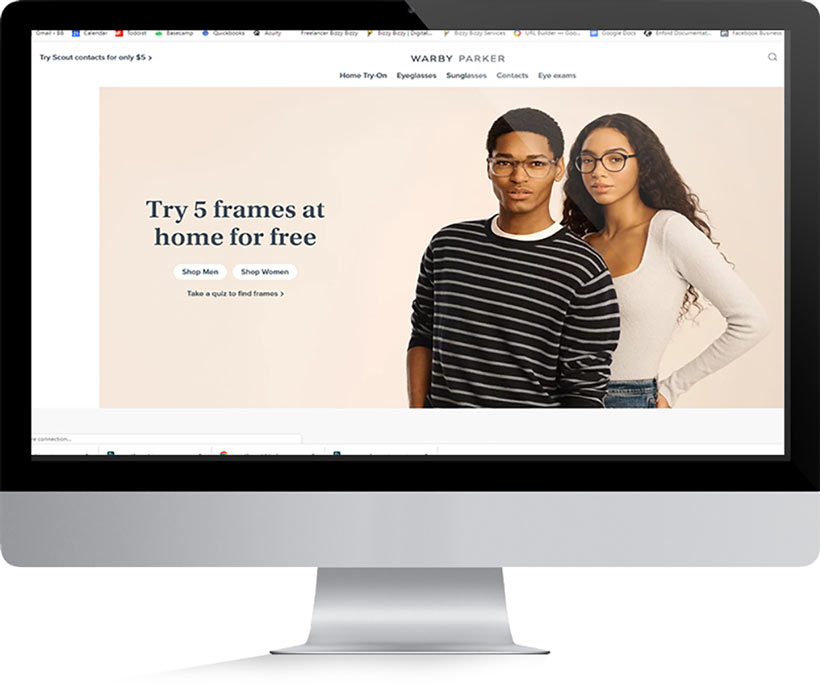
Brand Pricing Example: Warby Parker
Warby Parker’s mission is to offer designer eyewear at a revolutionary price. That means low pricing is at the heart of what they do, and without changing the entire mission of the business, Warby Parker can’t all of a sudden start selling high-end glasses without diluting their brand and losing brand loyalty.
With that said, just because they are known for affordable glasses doesn’t mean they are thought of as a “cheap” brand. Studies show that people with an income over $150,000 per year make up 18% of their customer base. This proves it is possible to build a chic brand while being known for your inexpensive products or services. In this case, they are relying on other elements of their brand (such as their design, imagery and store locations) to attract higher end consumers.
Customer Persona
Customer personas (also known as customer profiles or buyer personas) are used to identify a brand’s ideal clients. They are fictional, generalized representations of a person with real demographics and human emotions attached to them.
Having a customer persona (or multiple customer personas) will help you tailor your marketing messages and branding to a specific type of person with a specific set of pain points or problems. By talking directly to that group, you will be more likely to convert them.
Keep in mind that by speaking to a very specific audience, you will likely repel other audiences. That’s actually a good thing.
When you are first starting a business, sometimes it’s hard to know who your ideal client is. So you may want to start out a bit broader, for example, targeting women. Eventually, you’ll have enough experience to know that your ideal client is a 60-year-old woman living in a city who works a corporate job and is worried about losing her purpose once she retires.
Remember, you can’t be everything to everyone, so don’t try to be. As one author puts it, “When we try to be everything for everybody, we run the risk of being nothing for nobody. We end up watering down our business proposition and our brand promise in an attempt to be as broad as possible. We become so vague that no one knows what we are offering and our potential customers turn to other, more specific options.”
The more you get to know your ideal customers’ hopes and dreams, the easier it will be able to help them.
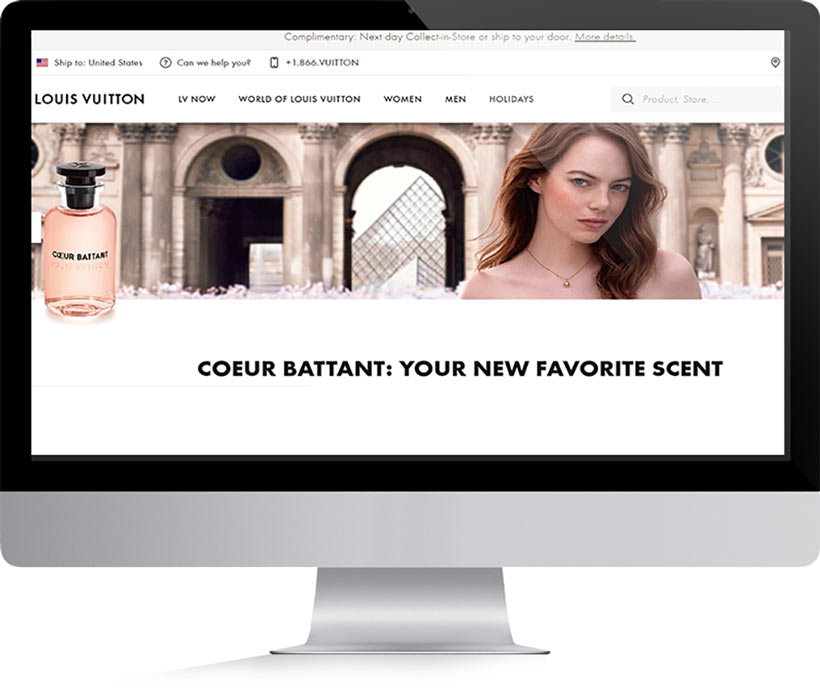
Brand Customer Personas: Louis Vuitton
Luxury retailer Louis Vuitton takes a totally different approach to their pricing than Warby Parker. Their fashion handbags retails for thousands of dollars and are a symbol of wealth and exclusivity.
The home page of their website features a large image of actress Emma Stone in front of classic architecture to sell a new perfume. They are speaking to a very specific customer persona whose inner desires are power, fame, beauty, and influence. They position the Louis Vuitton products as a way for customers to boost their social status and influence.
An example of one of their customer personas as shown on The Retailer blog is Alice: The Status Seeker. She is an affluent young adult who keeps up to date with fashion and seeks high social status and exclusivity of items to increase her self-esteem and feel above others who do not possess Louis Vuitton items.
By investing in celebrity spokespeople, Louis Vuitton is investing in their brand and thus able to command premium prices for their products. People aren’t just buying handbags. They are buying prestige that comes with being a part of such an exclusive brand.
Delivery
The delivery of your products and services directly affects your brand’s perception, position and reputation. And while delivery may encompass a literal delivery in the form of FedEx package on your doorstep, we’re not exclusively talking about delivering physical products here. Moreover, brand delivery is about how a customer actually pays for and receives your product or service.
Delivery is a part of the overall customer experience. It’s really about purchase process and receipt of goods and services. What is the pace, format and customer interaction like? How fast or easy is it for them to get what they want? What are the operational procedures that take place in order to deliver on your brand promise?
Do you deliver your accounting services by using a project management software or via email? Do you have high-touch customer service or automated, self-serve functionality? Are people strolling around a physical space talking to sales people or scrolling through products on a website chatting with a robot? All of these things impact your brand delivery.
In order to deliver on your brand promise, you and your staff need to have the appropriate process and tools. You need “soft” tools like brand guidelines as well as tactical tools like software that makes it easy to record information about customer’s past purchases.
Keep in mind, there are lots of different ways to deliver the same product or service. How you do it says a lot about your brand.
Brand Delivery Example: Netflix
Netflix has become a household name in TV and entertainment, and they largely did it by disrupting how rental movies were being delivered.
In the 90s, Blockbuster nearly had a monopoly on the movie rental market, and were taking advantage of that by charging customers enormous late fees for not returning movies to their store on time. Customers were fed up, so when Netflix hit the market with a movie-rental-by-mail model, people were interested. It was so much more convenient than having to go to Blockbuster every time you wanted a new movie. And returning the movie was even simpler. You never had to leave your house.
Later, Netflix pivoted into the streaming realm and once again changed how content was being delivered. They made it yet even easier and cheaper for people to consume television and movies, and now have attracted more than 150 million subscribers and rabid fans.
Building a Brand Around How & Where You Show Up
Channels & Media
With an integrated marketing strategy, a brand gains strength by using a variety of channels and media to reach clients and prospects.
Traditional offline marketing (known as “bricks”) might include giving out business cards or print materials at networking events, going to trade shows, doing door-to-door sales or having a “brick-and-mortar” location. “Clicks” refers to digital marketing via websites, email, social media and other online platforms. Because the number of marketing channels has grown exponentially in recent years, there is no shortage of ways to advertise your business. It’s very easy to get overwhelmed with the many “bricks and clicks” options and try to be everywhere.
Where you advertise, the type of print materials you distribute, what events you and your team attend and what social media platforms you spend time on all play a role in your overall brand.
Think about the difference between being a NASCAR sponsor versus buying a full-page ad in the New Yorker. You could literally have the same messaging, but the channel / media itself says something about your brand and the type of customers you are trying to attract.
To make the most of your marketing budget, find out where your customers spend the most time and invest in those channels first. Remember, it’s better to do a great job in fewer channels than trying to be everywhere.
Brand Channels & Media Example: GoDaddy
GoDaddy bought its first Super Bowl ad in 2005 and has largely made its name by having racy Super Bowl ads. While the ads themselves are controversial and certainly not the type of content you’d see in more conservative or serious media, the move to buy a coveted Super Bowl spot said a lot about the company. Super Bowl ads are known to be extremely expensive, funny and watched by almost 100 million people. The type of people who watch the Super Bowl are everyday folks who want to laugh and somewhat expect to be shocked. This goes hand in hand with GoDaddy’s brand archetypes of Jester, Everyman and Outlaw.
Advertising on such a large stage set them up as the dominant market leader in domain registration and website hosting, a position not even Google or Amazon can claim. (P.S. In case you haven’t heard, GoDaddy is the worst).
Culture
Workplace culture is increasingly becoming a part of a company’s brand, even for people who don’t work at the company.
As sited in Harvard Business Review, “a strong, differentiated company culture contributes to a strong, differentiated brand — and an extraordinary brand can support and advance an extraordinary culture.”
Brand culture includes other elements of a brand, such as values, mission and vision. But to develop authentic brand culture it’s not enough just to post your mission statement on a wall in your headquarters. Culture is developed with daily behaviors, attitudes and actions of both company leaders and employees.
Culture also includes company benefits and perks, as well as elements in your physical space. Because of this, culture is a big factor in recruiting and hiring.
It’s important that your brand aligns with your culture—even if you are a one-person show.
Even if you aren’t planning on hiring anytime soon, creating a “culture of one” for your business is still valuable. Setting official business hours, creating text messaging policies or a dress code may seem silly when it’s just you. But failing to establish a brand culture could breed inconsistency, which could confuse your customers or damage your brand in a bigger way.
The more intentional you are about your brand culture and making sure it aligns with the other elements of your brand, the better you will set yourself up for growth.
Culture Example: Hilton Hotels
Hilton was named by Fortune as one of the 2016 100 Best Places to Work. Hilton is intentional about integrating their daily work experience with their mission, vision and values. For example, Hilton brought in food trucks to its headquarters the week before Thanksgiving. Because holiday schedules get crazy between Thanksgiving and Christmas, this was a way thank their team. Why do this? Because it’s inline with their vision to be the most hospitable company in the world, including being hospitable to their own staff.
Between their diversity & inclusion efforts, their flexible work apparel and unique perks like adoption assistance, Hilton is a leader in authentic brand culture.
Space
Intentionally branding your space gives you opportunities to offer comfort and convenience, stimulate the senses, guide behaviors and opinions and reinforce brand messaging from other channels.
Your brand’s space could be a literal space, like your company’s retail location or business headquarters. It can also be a digital space like a website or social media profile. Much of your customer’s experience is impacted by the first space they come into contact with. So for example, if someone hears one of your ads on the radio, that gives them a first impression. But once they take the time to go to your website or visit your store, this is when your brand can really hook them or repel them.
Your brand should be on display and easily recognizable in both physical and digital environments. Branding may include using other elements of your brand such as your logo, colors, tagline and imagery. Anything tangible customers might leave with — from business cards to brochures, to packaging and products — should have the stamp of your logo and your website domain when possible. In addition, everything in your physical space should be an intentional choice from the furniture to the lighting to the books on the shelf and should showcase your unique brand personality.
Even if you work from home, consider that you may have video conference calls, so you have the opportunity to brand the space that appears on camera with your logo or other signature props.
On all your digital platforms, ensure your brand looks and feels the same everywhere. Create and use a brand style guide to create consistency with visuals and messaging.
If your business is largely dependent on customer traffic in a physical location (think restaurants or retailers), your space will be one of the areas of branding you invest in the most. If you don’t have a physical location (or you have one but customers never really go there), then you will want to invest more in your digital spaces like your website, which acts as a digital storefront.
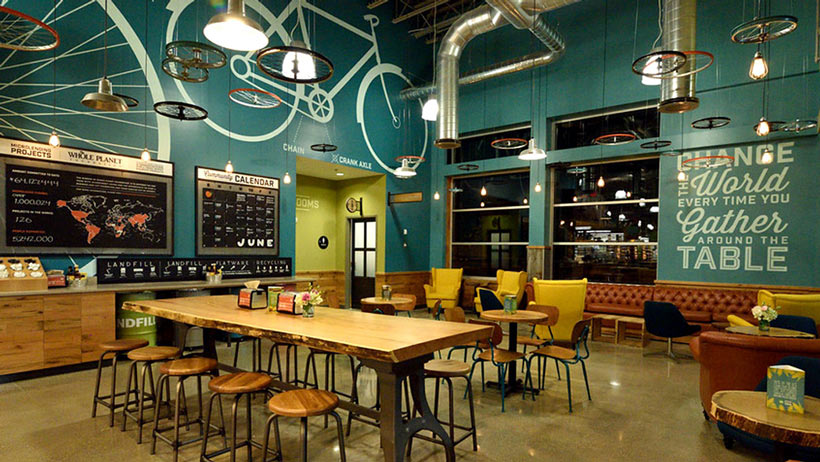
Brand Space Example: Whole Foods
Whole Foods is an upscale grocery chain that spends huge resources designing beautiful stores that entice customers to explore and buy. Whole Foods has been making efforts to attract Millennials, and they are using their space design to do it. New details like hanging bike wheels, wine barrel strappings, hand-drawn illustrations and typography, and reclaimed wood give the stores a more natural feel.
In addition, Whole Foods’ spaces look different from one location to the next so they better fit in with the local atmosphere and neighborhood. They often use local artists, history and materials when designing new stores. The space design of Whole Foods is arguably one of their most distinct brand elements when compared to many of their competitors.
Building a Brand Around What People Think
Position
Brand positioning is the concept of designing your offerings to take up a specific place in the mind of consumers to create a brand perception. Brand perception is what a potential customer believes a product or service represents. The position of your products and services directly affects your brand’s sales and customer expectations.
For example, do you want people to perceive you as the market leader? The trendiest? The friendliest? The highest quality?
Brand positioning statements are typically for internal use, but will have some overlap with key messages, taglines and other brand elements. In order to create a solid brand positioning strategy, you need to define the competitive context, your companies actual capabilities, your ideal customer’s needs and some kind of proof that your company can deliver on the brand positioning promise.
By having a brand positioning strategy, you can shape consumer preferences, which are related to brand loyalty and brand equity. When you achieve loyalty, people will purchase your brand over others because they perceive your products and services to be preferable in some way, even when the offerings are similar to competitors.
If you’ve been in business a while, focus groups of non-customers and surveys of people who didn’t buy are great ways to discover how people already perceive your brand. This information can then be used to tighten up or modify your brand positioning.
Brand Position Example: Wal-Mart
Walmart’s brand position is widely known, even by people who don’t shop there. Their stuff is cheap! Founder Sam Walton reportedly recognized a hole in the competitive discount retail market. Retailers like Kmart would open stores only in towns with over 50,000 people. Sam decided to open Walmart stores in small towns with a population of around 5,000. He knew the small-town consumer mindset well—people in those towns always bought products at the lowest price. With some research, he discovered by discounting an item 20% lower than competitors, he could sell three times the volume. And thus, the brand position of the lowest price was born.
Walmart’s past slogan “Always Low Prices” points to that brand positioning. They have since couched that tagline and replaced it with “Save Money. Live Better,” which also puts savings at the forefront of the brand.
Reputation
Warren Buffett is said to have quipped, “It takes 20 years to build a reputation and 5 minutes to ruin it.” The same could be said about brand reputation.
What people say about your brand in reviews, on social media and via word-of-mouth conversations creates your brand reputation.
A brand’s reputation can be positive, negative, acutely insightful or highly inaccurate. And while you can’t control your brand’s reputation, it is essential to understand it and do what you can to build a positive reputation.
Social listening is a relatively new way gives you access to what people are saying about your brand, industry, or competitors across social media and the web. But for smaller brands and local businesses who may not be able to gather a substantial amount of online data, you may need to find other ways to learn about your brand’s reputation. One simple way to build and improve your brand’s reputation is simply to ask for reviews from satisfied customers.
If you have had a bit of bad press or something that has otherwise damaged your reputation, you may want to consider hiring a “reputation management company” to help you salvage your image. If you sense you have a brand reputation problem but you’re not sure, do a survey of your past clients to understand where the problem lies.
Above all, don’t ignore bad reviews or feedback, especially on public-facing websites. Respectfully and politely address all feedback, positive or negative, and move the conversation offline if it gets negative.
Brand Reputation Example: Domino’s Pizza
In 2010, Domino’s Pizza chain had a big brand reputation problem. Even people who had never had their pizza thought that Domino’s pizza was terrible. And this reality of public opinion was hurting sales.
The thing is, plenty of people did like Domino’s Pizza, so it would have been easy to ignore this reputation problem. But instead of pushing more positive messaging in their advertising about how delicious their pizza is, they did focus groups to understand the problem.
And then Domino’s did something crazy. They came out with the “Our Pizza Sucks” ad campaign. The ads showed executives watching focus groups berating the pizza, saying “the sauce tastes like ketchup,” and “the crust tastes like cardboard.” The company owned up to its brand reputation in the campaign and promised to reinvent their recipes and do better. The chain’s sales grew 14.5% in the quarter after the campaign.
Not every company will be able to turn around a bad perception with results like that, but the first step is understanding what the reputation is.
Conclusion
If you’ve made it this far, you understand that branding is not your logo. Branding is everything your business is and everything it strives to be.
It’s big, important stuff! But you don’t necessarily need to work on all 25 Elements of a Brand in order to have a strong brand. Most businesses will bring forward just a few of these elements—the ones that are most distinctive.
A clear brand strategy helps you stay focused on your mission and vision as an organization instead of jumping on every new idea that pops in your head. Brand guidelines can help keep your brand consistent and strong across every channel.
If you need help with your branding efforts, contact Bizzy Bizzy today. Developing a brand takes time, but we can jumpstart the process with our unique and interactive 1 Day® Branding service.
Remember, the more you invest in your brand, the more value it has!

